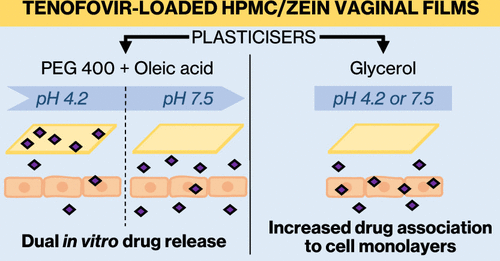Influence of Plasticizers on the pH-Dependent Drug Release and Cellular Interactions of Hydroxypropyl Methylcellulose/Zein Vaginal Anti-HIV Films Containing Tenofovir

Vaginal films featuring the pH-dependent release of tenofovir (TFV) were developed for the prevention of sexual transmission of human immunodeficiency syndrome (HIV). Films based on hydroxypropyl methylcellulose and zein were prepared incorporating different plasticizers [oleic acid, lactic acid, glycerol, and polyethylene glycol 400 (PEG)] and evaluated for in vitro drug release in an acidic simulated vaginal fluid (pH 4.2) and a slightly alkaline mixture of simulated seminal and vaginal fluids (pH 7.5).
Results revealed that optimal biphasic TFV release was possible with proper combination of plasticizers (PEG and oleic acid, 1:7 w/w) and by adjusting the plasticizer/matrix-forming material ratio. The films had similar or higher levels of TFV associated with genital epithelial cells (Ca Ski or HEC-1-A cells) but lower drug permeability compared to the free drug. These data confirm that films have the potential to achieve suitable mucosal levels of TFV with low systemic exposure. The films developed could protect women from HIV sexual transmission.
Read the article here and download the supporting information as a PDF here
Article Information: Fernando Notario-Pérez, Raúl Cazorla-Luna, Araceli Martín-Illana, Joana Galante, Roberto Ruiz-Caro, Bruno Sarmento, José das Neves, and María-Dolores Veiga. Biomacromolecules Article ASAP. DOI:10.1021/acs.biomac.0c01609

